Dremel 398 User Manual
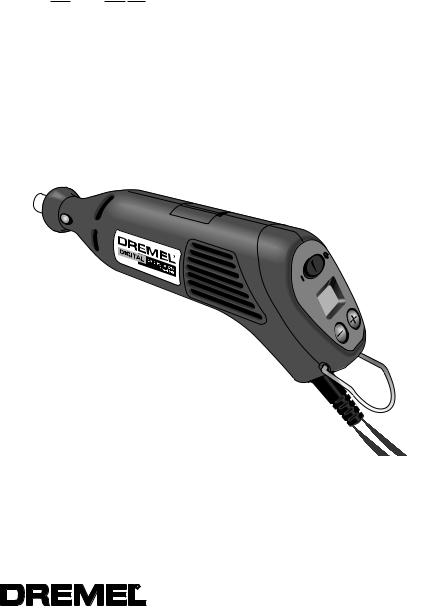






 DIGITAL High
DIGITAL High
Speed Rotary Tool
Operating/Safety Instructions
Model 398
HONESTLY NOW … Have you read this OWNER’S MANUAL?
Parlez-vous français?
Voir page 25
¿Habla español? Vea página 49
• |
Safety |
|
• |
Assembly |
|
• |
Operation |
|
• |
Maintenance |
|
• |
Accessory Information |
|
• |
Warranty |
|
• |
Accessory Kits List |
|
• |
Service Parts |
|
|
P.O. Box 1468 |
© |
|
Racine, Wisconsin 53401 |
Robert Bosch Tool |
|
|
Corporation |
1-800-437-3635 |
1997 |
|
All Rights Reserved |
||
http://www.dremel.com |
||
|
Dremel brand products are manufactured and sold by the
Dremel Division of Robert Bosch Tool Corporation
2610925503 01/05 |
Printed in Mexico |

Power Tool Safety Rules
! |
WARNING |
Read and understand all instructions. Failure to follow all instructions listed below, may |
result in electric shock, fire and/or serious personal injury. |
||
|
|
SAVE THESE INSTRUCTIONS |
Work Area
Keep your work area clean and well lit. Cluttered benches and dark areas invite accidents.
Do not operate power tools in explosive atmospheres, such as in the presence of flammable liquids, gases, or dust. Power tools create sparks which may ignite the dust or fumes.
Keep by-standers, children, and visitors away while operating a power tool. Distractions can cause you to lose control.
Electrical Safety
Double Insulated tools are equipped with a polarized plug (one blade is wider than the other.) This plug will fit in a polarized outlet only one way. If the plug does not fit fully in the outlet, reverse the plug. If it still does not fit, contact a qualified electrician to install a polarized outlet. Do not change the plug in any way. Double Insulation 


 eliminates the need for the three wire grounded power cord and grounded power supply system. Before plugging in the tool, be certain the outlet voltage supplied is within the voltage marked on the nameplate. Do not use “AC only” rated tools with a DC power supply.
eliminates the need for the three wire grounded power cord and grounded power supply system. Before plugging in the tool, be certain the outlet voltage supplied is within the voltage marked on the nameplate. Do not use “AC only” rated tools with a DC power supply.
Avoid body contact with grounded surfaces such as pipes, radiators, ranges and refrigerators. There is an increased risk of electric shock if your body is grounded. If operating the power tool in damp locations is unavoidable, a Ground Fault Circuit Interrupter must be used to supply the power to your tool. Electrician’s rubber gloves and footwear will further enhance your personal safety.
Don't expose power tools to rain or wet conditions.
Water entering a power tool will increase the risk of electric shock.
Do not abuse the cord. Never use the cord to carry the tools or pull the plug from an outlet. Keep cord away from heat, oil, sharp edges or moving parts. Replace damaged cords immediately. Damaged cords increase the risk of electric shock.
When operating a power tool outside, use an outdoor extension cord marked "W-A" or "W." These cords are rated for outdoor use and reduce the risk of electric shock. Refer to “Recommended sizes of Extension Cords” in the Accessory section of this manual.
Personal Safety
Stay alert, watch what you are doing and use common sense when operating a power tool. Do not use tool while tired or under the influence of drugs, alcohol, or medication. A moment of inattention while operating power tools may result in serious personal injury.
Dress properly. Do not wear loose clothing or jewelry. Contain long hair. Keep your hair, clothing, and gloves away from moving parts. Loose clothes, jewelry, or long hair can be caught in moving parts. Keep handles dry, clean and free from oil and grease.
Avoid accidental starting. Be sure switch is “OFF” before plugging in. Carrying tools with your finger on the switch or plugging in tools that have the switch “ON” invites accidents.
Remove adjusting keys or wrenches before turning the tool “ON”. A wrench or a key that is left attached to a rotating part of the tool may result in personal injury.
Do not overreach. Keep proper footing and balance at all times. Proper footing and balance enables better control of the tool in unexpected situations.
Use safety equipment. Always wear eye protection.
Dust mask, non-skid safety shoes, hard hat, or hearing protection must be used for appropriate conditions.
Tool Use and Care
Use clamps or other practical way to secure and support the workpiece to a stable platform. Holding the work by hand or against your body is unstable and may lead to loss of control.
Do not force tool. Use the correct tool for your application. The correct tool will do the job better and safer at the rate for which it is designed.
Do not use tool if switch does not turn it “ON” or
“OFF”. Any tool that cannot be controlled with the switch is dangerous and must be repaired.
Disconnect the plug from the power source before making any adjustments, changing accessories, or storing the tool. Such preventive safety measures reduce the risk of starting the tool accidentally.
Store idle tools out of reach of children and other untrained persons. Tools are dangerous in the hands of untrained users.
Page 2

Maintain tools with care. Keep cutting tools sharp and clean. Properly maintained tools, with sharp cutting edges are less likely to bind and are easier to control. Any alteration or modification is a misuse and may result in a dangerous condition.
Check for misalignment or binding of moving parts, breakage of parts, and any other condition that may affect the tools operation. If damaged, have the tool serviced before using. Many accidents are caused by poorly maintained tools. Develop a periodic maintenance schedule for your tool.
Use only accessories that are recommended by the manufacturer for your model. Accessories that may be suitable for one tool, may become hazardous when used on another tool.
Service
Tool service must be performed only by qualified repair personnel. Service or maintenance performed by unqualified personnel could result in a risk of injury. For example: internal wires may be misplaced or pinched, safety guard return springs may be improperly mounted.
When servicing a tool, use only identical replacement parts. Follow instructions in the Maintenance section of this manual. Use of unauthorized parts or failure to follow Maintenance Instructions may create a risk of electric shock or injury. Certain cleaning agents such as gasoline, carbon tetrachloride, ammonia, etc. may damage plastic parts.
Safety Rules for Rotary Tools
Accessories must be rated for at least the speed recommended on the tool warning label. Wheels and other accessories running over rated speed can fly apart and cause injury.
Hold tool by insulated gripping surfaces when performing an operation where the cutting tool may contact hidden wiring or its own cord. Contact with a "live" wire will make exposed metal parts of the tool "live" and shock the operator. If cutting into existing walls or other blind areas where electrical wiring may exist is unavoidable, disconnect all fuses or circuit breakers feeding this worksite.
Do not operate the flexible shaft with a sharp bend.
Over bending the shaft can generate excessive heat on the jacket or hand piece. The recommended minimum is 6" radius.
Always disconnect the power cord from the power source before making any adjustments or attaching any accessories. You may unexpectedly cause the tool to start leading to serious personal injury.
Be aware of the switch location, when placing the tool down or when picking the tool up. You may accidentally activate the switch.
Always hold the hand piece firmly in your hands during the start-up. The reaction torque of the motor, as it accelerates to full speed, can cause the shaft to twist.
Always wear safety goggles and dust mask. Use only in well ventilated area. Using personal safety devices and working in safe environment reduces risk of injury.
After changing the bits or making any adjustments, make sure the collet nut and any other adjustment devices are securely tightened. Loose adjustment device can unexpectedly shift, causing loss of control, loose rotating components will be violently thrown.
Do not reach in the area of the spinning bit. The proximity of the spinning bit to your hand may not always be obvious.
Allow brushes to run at operating speed for at least one minute before using wheel. During this time no one is to stand in front or in line with the brush.
Loose bristles or wires will be discharged during the run-in time.
Wire and bristle brushes must never be operated at speeds greater than 15,000/min. Direct the discharge of the spinning wire brush away from you. Small particles and tiny wire fragments may be discharged at high velocity during the “cleaning” action with these brushes and may become imbedded in your skin. Bristles or wires will be discharged from the brush at high speeds.
Wear protective gloves and face shield with wire or bristle brushes. Apply wire or bristle brushes lightly to the work as only the tips of the wire/bristles do the work. “Heavy” pressure on bristles will cause the wire or bristle to become overstressed, resulting in a wiping action and will cause the bristles/wire to be discharged.
Carefully handle both the tool and individual grinding wheels to avoid chipping or cracking. Install a new wheel if tool is dropped while
Page 3

Safety Rules for Rotary Tools - (cont.)
grinding. Do not use a wheel that may be damaged.
Fragments from a wheel that bursts during operation will fly away at great velocity possibly striking you or bystanders.
Never use dull or damaged bits. Sharp bits must be handled with care. Damaged bits can snap during use. Dull bits require more force to push the tool, possibly causing the bit to break.
Use clamps to support workpiece whenever practical. Never hold a small workpiece in one hand and the tool in the other hand while in use. Allow for sufficient space, at least 6", between your hand and the spinning bit. Round material such as dowel rods, pipes or tubing have a tendency to roll while being cut, and may cause the bit to “bite” or jump toward you. Clamping a small workpiece allows you to use both hands to control the tool.
Inspect your workpiece before cutting. When cutting irregularly shaped workpieces, plan your work so it will not slip and pinch the bit and be torn from your hand. For example, if carving wood, make sure there are no nails or foreign objects in the workpiece. Nails or foreign objects can cause the bit to jump.
Never start the tool when the bit is engaged in the material. The bit cutting edge may grab the material causing loss of control of the cutter.
Avoid bouncing and snagging the wheel, especially when working corners, sharp edges etc. This can cause loss of control and kick-back.
The direction of feed with the bit into the material when carving, routing or cutting is very important. Always feed the bit into the material in the same direction as the cutting edge is exiting from the material (which is the same direction as the chips are thrown). Feeding the tool in the wrong direction, causes the cutting edge of the bit to climb out of the work and pull the tool in the direction of this feed.
If the workpiece or bit becomes jammed or bogged down, turn the tool “OFF” by the switch. Wait for all moving parts to stop and unplug the tool, then work to free the jammed material. If the switch to the tool is left “ON” the tool could restart unexpectedly causing serious personal injury.
Do not leave a running tool unattended, turn power off. Only when tool comes to a complete stop it is safe to put it down.
Do not grind or sand near flammable materials.
Sparks from the wheel could ignite these materials.
Do not touch the bit or collet after use. After use the bit and collet are too hot to be touched by bare hands.
Regularly clean the tool's air vents by compressed air. Excessive accumulation of powdered metal inside the motor housing may cause electrical failures.
Do not allow familiarity gained from frequent use of your rotary tool to become commonplace. Always remember that a careless fraction of a second is sufficient to inflict severe injury.
Do not alter or misuse tool. Any alteration or modification is a misuse and may result in serious personal injury.
This product is not intended for use as a dental drill, in human or veterinary medical applications.
Serious personal injury may result.
When using the steel saws, cutoff wheels, high speed cutters or tungsten carbide cutters, always have the work securely clamped. Never attempt to hold the work with one hand while using any of these accessories. The reason is that these wheels will grab if they become slightly canted in the groove, and can kickback causing loss of control resulting in serious injury. Your second hand should be used to steady and guide the hand holding the tool. When a cutoff wheel grabs, the wheel itself usually breaks. When the steel saw, high speed cutters or tungsten carbide cutter grab, it may jump from the groove and you could lose control of the tool.
! |
WARNING |
Some dust created by power |
|
sanding, sawing, grinding, |
|||
|
|
drilling, and other construction activities contains chemicals known to cause cancer, birth defects or other reproductive harm. Some examples of these chemicals are:
•Lead from lead-based paints,
•Crystalline silica from bricks and cement and other masonry products, and
•Arsenic and chromium from chemically treated lumber.
Your risk from these exposures varies, depending on how often you do this type of work. To reduce your exposure to these chemicals: work in a well ventilated area, and work with approved safety equipment, such as those dust masks that are specially designed to filter out microscopic particles.
Page 4
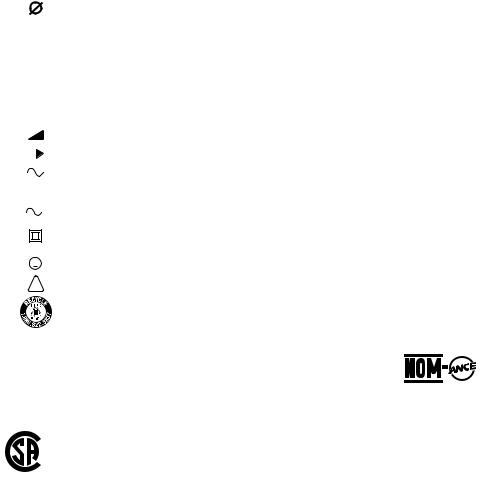
Symbols
IMPORTANT: Some of the following symbols may be used on your tool. Please study them and learn their meaning. Proper interpretation of these symbols will allow you to operate the tool better and safer.
Symbol |
Name |
Designation/Explanation |
|||||
|
|
V |
Volts |
Voltage (potential) |
|||
|
|
|
|
|
|
|
|
|
|
A |
Amperes |
Current |
|||
|
|
|
|
|
|
|
|
|
|
Hz |
Hertz |
Frequency (cycles per second) |
|||
|
|
W |
Watt |
Power |
|||
|
|
|
|
|
|
|
|
|
|
kg |
Kilograms |
Weight |
|||
|
min |
Minutes |
Time |
||||
|
|
|
|
|
|
|
|
|
|
s |
Seconds |
Time |
|||
|
|
|
|
|
|
|
|
|
|
|
|
|
|
Diameter |
Size of drill bits, grinding wheels, etc. |
|
|
n0 |
No load speed |
Rotational speed, at no load |
|||
.../min |
Revolutions or reciprocation per minute |
Revolutions, strokes, surface speed, |
|||||
|
|
|
|
|
|
|
orbits etc. per minute |
|
|
|
|
|
|
|
|
0 |
|
|
|
Off position |
Zero speed, zero torque... |
||
|
|
|
|
|
|
|
|
1, 2, 3, ... |
Selector settings |
Speed, torque or position settings. |
|||||
I, II, III, |
|
Higher number means greater speed |
|||||
0 |
|
|
|
|
Infinitely variable selector with off |
Speed is increasing from 0 setting |
|
|
|
|
|
|
|
Arrow |
Action in the direction of arrow |
|
|
|
|
|
|
||
|
|
|
|
|
|
||
|
|
|
|
|
|
|
|
|
|
|
|
|
|
Alternating current |
Type or a characteristic of current |
|
|
|
|
|
|
Direct current |
Type or a characteristic of current |
|
|
|
|
|
|
||
|
|
|
|
|
|
|
|
|
|
|
|
|
|
Alternating or direct current |
Type or a characteristic of current |
|
|
|
|
|
|
||
|
|
|
|
|
|
|
|
|
|
|
|
|
|
Class II construction |
Designates Double Insulated |
|
|
|
|
|
|
||
|
|
|
|
|
|
|
Construction tools. |
|
|
|
|
|
|
|
|
|
|
|
|
|
|
|
|
|
|
|
|
|
|
Earthing terminal |
Grounding terminal |
|
|
|
|
|
|
||
|
|
|
|
|
|
Warning symbol |
Alerts user to warning messages |
|
|
|
|
|
|
||
|
|
|
|
|
|
||
|
|
|
|
|
|
|
|
|
|
|
|
|
|
Ni-Cad RBRC seal |
Designates Ni-Cad battery recycling |
|
|
|
|
|
|
|
program |
|
|
|
|
|
|
|
|
This symbol designates that this tool is listed by Underwriters Laboratories.
This symbol designates that this tool is listed by the Canadian Standards Association.
This symbol designates that this tool is listed to Canadian Standards by Underwriters Laboratories.
This symbol designates that this tool is listed by Underwriters Laboratories, and listed to Canadian Standards by Underwriters Laboratories.
This symbol designates that
this tool complies to NOM Mexican Standards.
Page 5
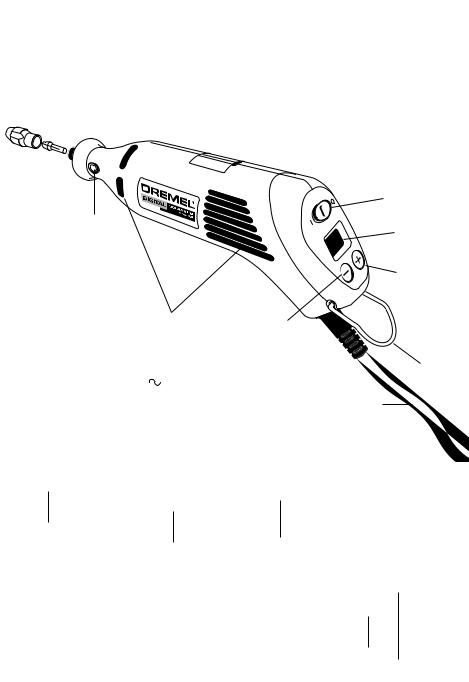
Functional Description and Specifications
! |
WARNING |
Disconnect the plug from the power source before making any assembly, adjustments |
|
or changing accessories. Such preventive safety measures reduce the risk of starting the |
|||
|
|
tool accidentally.
Rotary Tool
COLLET NUT |
FIG. 1 |
||
|
COLLET |
|
|
|
|
|
|
|
|
|
|
|
|
SWITCH |
|
SHAFT LOCK |
|
L.C.D. |
|
BUTTON |
|
||
|
DISPLAY |
||
|
|
||
|
|
SPEED UP |
|
|
|
BUTTON |
|
|
VENTILATION |
SPEED |
|
|
OPENINGS |
DOWN |
|
|
|
BUTTON |
|
Model number |
398 |
HANGER |
|
Voltage rating |
120V 50 - 60Hz |
||
|
|||
Amperage rating |
1.15A |
CORD |
|
No load speed |
n0 5,000-35,000/min |
||
|
|||
Collet capacities |
1/32”, 1/16", 3/32", 1/8" |
|
FLEXIBLE
SHAFT WRENCH
CORE
DRIVER
CAP
COLLET NUT
(NOT INCLUDED)
COLLET
Page 6
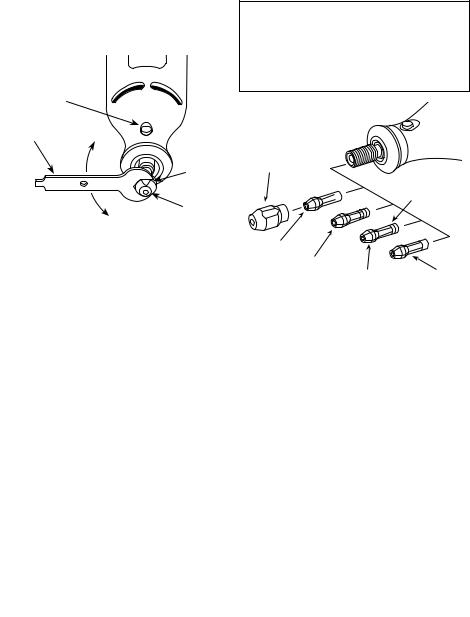
Assembly
! WARNING |
Always unplug Rotary Tool before |
changing accessories, changing |
collets or servicing your Rotary Tool.
SHAFT LOCK
BUTTON
COLLET
WRENCH TO TIGHTEN
COLLET
NUT
COLLET
TO LOOSEN
COLLET
To loosen, first press shaft lock button and rotate the shaft by hand until the lock engages the shaft preventing further rotation.
! |
CAUTION |
Do not engage lock while the |
|
Rotary Tool is running. |
|||
|
|
With the shaft lock engaged use the collet wrench to loosen the collet nut if necessary. Change accessories by inserting the new one into the collet as far as possible to minimize runout and unbalance. With the shaft lock engaged, finger tighten the collet nut until the accessory shank is gripped by the collet. Avoid excessive tightening of the collet nut.
COLLETS
Four different size collets (see illustration), to accommodate different shank sizes, are available for your Rotary Tool. To install a different collet, remove the collet nut and remove the old collet. Insert the unslotted end of the collet in the hole in the end of the tool shaft. Replace collet nut on the shaft. Always use the collet which matches the shank size of the accessory you plan to use. Never force a larger diameter shank into a collet.
BALANCING ACCESSORIES
For precision work, it is important that all accessories be in good balance (much the same as the tires on your automobile). To true up or balance an accessory, slightly loosen collet nut and give the accessory or collet a 1/4 turn. Retighten collet nut and run the Rotary Tool. You should be able to tell by the sound and feel if your accessory is running in balance. Continue adjusting in
COLLET IDENTIFICATION CHART — Collet sizes can be identified by the rings on the back end of collet.
1/32" Collet has one (1) ring. 1/16" Collet has two (2) rings. 3/32" Collet has three (3) rings. 1/8" Collet has no rings.
COLLET
NUT
|
|
IDENTIFICATION |
|
|
RINGS |
480 |
|
|
1/8" |
|
|
COLLET 481 |
|
|
3/32" |
482 |
483 |
COLLET |
1/16" |
1/32" |
|
COLLET |
COLLET |
this fashion until best balance is achieved. To maintain balance on abrasive wheel points, before each use, with the wheel point secured in the collet, turn on the Rotary Tool and run the 415 Dressing Stone lightly against the revolving wheel point. This removes high spots and trues up the wheel point for good balance.
The hanger is provided for the use of hanging your tool while using the flex-shaft or for storage. If you do not use the hanger, remove it from the tool and snap it back into place underneath the cord so it will be out of the way while the tool is in use.
Flex-shaft to Rotary Tool installation
! WARNING |
Not for use with router bits. Use |
|
with router bits will cause |
||
kickback. |
||
|
To attach the 225 flex-shaft (sold separately) to the Rotary Tool press the shaft lock and remove the collet nut, then remove the collet and housing cap as shown in Figure 1. Install the driver cap on the motor shaft as shown in Figure 2 and tighten.
! |
CAUTION |
To prevent damage to tool, do not |
|
overtighten driver cap. Tighten |
|||
|
|
the driver cap finger tight and then tighten an additional 1/3 turn with the wrench. (Wrench included with your Rotary Tool kit).
Page 7
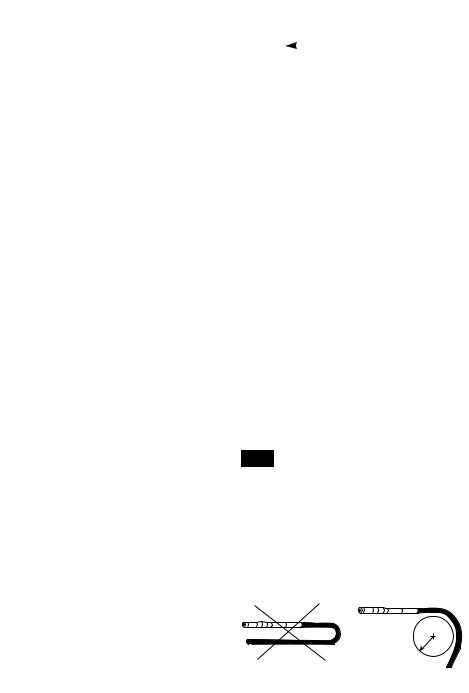
Assembly - (cont.)
Screw the flexible shaft onto the Rotary Tool housing being sure that the square end of the center core engages the square hole socket in the driver cap Figure 3.
Do not pull out center core to engage into driver cap.
This could cause disengagement of center core from handpiece. If tool stops when shaft is bent, center core may be lodged in driver cap. Loosen shaft and remove core from driver cap. Then screw flexible shaft onto rotary tool housing again.
Flex-Shaft Collet Assembly
The collet assembly consists of a collet nut and collet. To change bits use the wrench and a bit. Insert the shank portion of any bit (1/8" shank recommended) through the opening in the flex-shaft hand piece to lock the shaft. With the shaft secured, use the wrench to loosen or tighten the collet nut as shown in Figure 4. With the collet nut loose, insert an accessory or bit as deeply as possible to avoid wobble during use. Retighten the collet nut.
Collet Removal and Replacement
Four different size collets to accommodate different shank sizes, are available for your flex-shaft. To install a different collet, remove the collet nut and remove the old collet. Insert the unslotted end of the collet in the hole in the end of the flex-shaft. Replace collet nut on the shaft. Always use the collet which matches the shank size of the accessory you plan to use.
Never force a larger diameter shank into a collet.
Flexible Shaft Lubrication
The flexible shaft should be lubricated after every 2530 hours of use. To lubricate, unscrew the flexible shaft assembly from the motor housing. Pull the center core out of the flexible shaft assembly. Wipe a very thin film of a good quality, high temperature grease on to the center core.
! |
CAUTION |
To prevent damage to tool do |
|
not over grease shaft. Too much |
|||
|
|
grease will cause the unit to overheat. Automotive wheel bearing grease should be used.
Reattach the flex-shaft to the rotary tool.
! |
WARNING |
Do not operate the flexible shaft |
|
with a sharp bend (A). This can |
|||
|
|
generate excessive heat and will reduce tool and flexshaft life. The recommended minimum is 6" radius (B).
Contents of 225 Flex-shaft Attachment
Qty. |
Description |
1 |
Flex-Shaft Assembly (42" long) |
1 |
Driver Cap |
FIG. 1 |
|
|
HOUSING |
|
|
|
CAP |
|
|
|
|
COLLET
NUT
|
DRIVER |
FIG. 2 |
CAP |
MOTOR
SHAFT
|
FLEXIBLE |
|
|
SHAFT |
|
FIG. 3 |
||
|
DRIVER CAP
COLLET (inside)
FIG. 4
COLLET
NUT
BIT
6" RADIUS
A. B.
Page 8
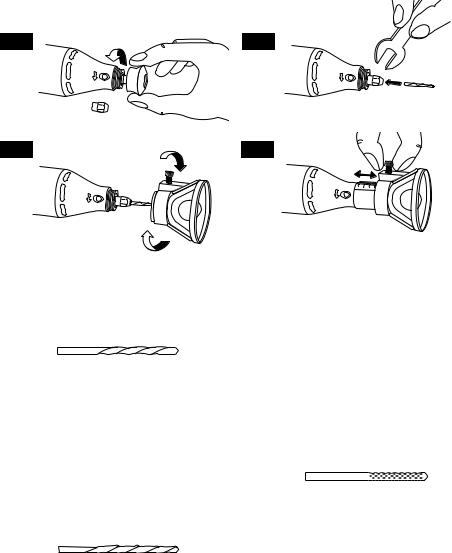
Cutting Guide Installation
The cutting guide 565 (sold separately) comes completely assembled and ready to use. For use in a variety of materials up to 3/4” thick. Match the bit type to material to be cut. Always hold the tool firmly, using slow steady pressure to make cuts.
To attach, follow the four steps shown below.
FIG. 1
Important: When viewing the tool from the top, the bit rotates clockwise. Feed direction of cutting must be counter-clockwise.
FIG. 2
FIG. 3 |
FIG. 4 |
43/ |
2/1 |
41/ |
0
Operating Instructions for Cutting Guide Attachment
#560
Drywall Cutting Bit
For use in drywall.
•When inserting the #560 bit into your MultiPro tool, make sure that the bit has been inserted as far as possible.
•When making freehand cuts in drywall, example repairing a hole in drywall, use the Multipurpose bit #561,cutting in a clockwise direction. When using a template (outlet box) behind the drywall, use the drywall bit #560, cutting in a counter-clockwise direction.
#561
Multipurpose Cutting Bit
For use in wood, plastics, drywall, fiberglass, vinyl or aluminum siding, acoustical tile and laminates.
•When inserting the #561 bit into your MultiPro tool, make sure that the bit has been inserted as far as possible.
•When making freehand cuts in Drywall, example repairing a hole in drywall, use the Multipurpose bit
#561, cutting in a clockwise direction. When using a template (outlet box) behind the drywall, use the drywall bit #560, cutting in a counter-clockwise direction.
• When using #561, Multipurpose Cutting Bit, and #562, Tile Cutting Bit, start the bit into the material at a 45 degree angle and then slowly bring it to a 90 degree angle to begin the cut.
#562
Tile Cutting Bit
For use on wall tile, cement board and plaster
•When inserting the #562 bit into your MultiPro tool, it is very important that 1/16”-1/8” of smooth shank remains visible above the collet.
•When using #561, Multipurpose Cutting Bit, and #562, Tile Cutting Bit, start the bit into the material at a 45 degree angle and then slowly bring it to a 90 degree angle to begin the cut.
•NOT FOR USE ON FLOOR TILE
Page 9
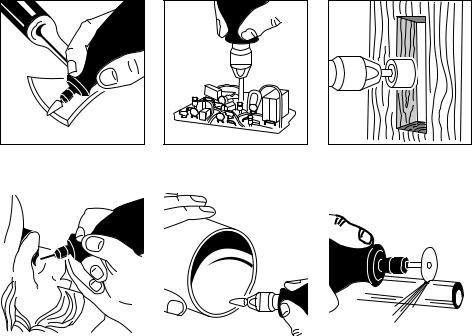
Operating Instructions for Rotary Tool and Flex-Shaft Attachment
The following operation applies to the Rotary Tool and Flex-Shaft attachment, except the pictures depict the Rotary Tool.
The Rotary Tool is a handful of high-speed power. It serves as a carver, grinder, polisher, sander, cutter, power brush, drill and more.
The Rotary Tool has a small, powerful electric motor, is comfortable in the hand, and is made to accept a large variety of accessories including abrasive wheels, drill bits, wire brushes, polishers, engraving cutters, router bits, and cutting wheels. Accessories come in a variety of shapes and permit you to do a number of different jobs. As you become familiar with the range of accessories and their uses, you will learn just how versatile the Rotary Tool is. You’ll see dozens of uses you hadn’t thought of before.
The real secret of the Rotary Tool is its speed. To understand the advantages of its high speed, you have to know that the standard portable electric drill runs at speeds up to 2,800 revolutions per minute. The Rotary Tool operates at speeds up to 35,000 revolutions per
minute. The typical electric drill is a low-speed, high torque tool; the Rotary Tool is just the opposite – a high-speed, low torque tool. The chief difference to the user is that in the high speed tools, the speed combined with the accessory mounted in the collet does the work. You don’t apply pressure to the tool, but simply hold and guide it. In the low speed tools, you not only guide the tool, but also apply pressure to it, as you do, for example, when drilling a hole.
It is this high speed, along with its compact size and wide variety of special accessories, that makes the Rotary Tool different from other power tools. The speed enables it to do jobs low speed tools cannot do, such as cutting hardened steel, engraving glass, etc.
Getting the most out of your Rotary Tool is a matter of learning how to let this speed work for you.
Sharpen Tools |
|
Precise Drilling |
|
Shape Wood |
|
|
|
|
|
|
|
|
|
|
Carve Wood |
Deburr Metal |
Cut |
Page 10
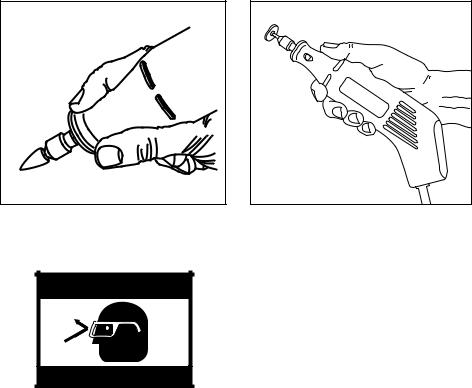
Using the Rotary Tool
The first step in learning to use the Rotary Tool is to get the “feel” of it. Hold it in your hand and feel its weight and balance. Feel the taper of the housing. This taper permits the Rotary Tool to be grasped much like a pen or pencil.
When you turn on the tool for the first time, hold it away from your face. Accessories can be damaged during handling, and can fly apart as they come up to speed. This is not common, but it does happen.
Practice on scrap materials first to see how the Rotary Tool cuts. Keep in mind that the work is done by the speed of the tool and by the accessory in the collet. You should not lean on or push the tool into the work.
Instead, lower the spinning accessory lightly to the work and allow it to touch the point at which you want cutting (or sanding or etching, etc.) to begin. Concentrate on guiding the tool over the work using very little pressure from your hand. Allow the accessory to do the work.
Usually, it is best to make a series of passes with the tool rather than attempt to do all the work in one pass. To make a cut, for example, pass the tool back and forth over the work, much as you would a small paint brush. Cut a little material on each pass until you reach the desired depth. For most work, the gentle touch is best. With it, you have the best control, are less likely to make errors, and will get the most efficient work out of the accessory.
Questions or Problems ? Call 1-800-437-3635 or check our website at www.Dremel.com
For best control in close work, grip the Rotary Tool like a pencil between your thumb and forefinger.
The “handgrip” method of holding the tool is used for operations such as grinding a flat surface or using cutoff wheels
 WARNING
WARNING
! |
CAUTION |
Whenever you hold the tool, be |
|
careful not to cover the air vents |
|||
|
|
with your hand. This blocks the air flow and causes the motor to overheat.
Wear Eye Protection
Page 11

Operating Speeds for Accessories
Electronic Feedback Circuitry (EFC)
Your tool is equipped with a internal electronic feedback system that provides a "soft start", which will reduce the stresses that occur from a high torque start. The system also helps to keep the preselected rotating speed virtually constant between no-load and load conditions.
Set the speed indicator to fit the job; to achieve the best job results when working with different materials, the speed of the Rotary Tool should be regulated. Model 398 Rotary Tool has an integral speed control.
! |
CAUTION |
An external speed control |
|
should never be used with this |
|||
tool. |
|
||
|
|
To select the right speed for each job, use a practice piece of material. Vary speed to find the best speed for the accessory you are using and the job to be done.
NOTE: Speed is affected by voltage changes. A reduced incoming voltage will slow the RPM of the tool, especially at the lowest setting. If your tool appears to be running slowly increase the speed setting accordingly.
Digital Speed Selector Switch
Your rotary tool features a digital speed selector switch which displays an L.C.D. reading of the tool’s RPM. The speed can be selected from 5,000 RPM to 35,000 RPM in 1,000 RPM increments by simply depressing the positive or negative buttons on the switch.
TO TURN TOOL "ON": slide ON/OFF switch to the "ON" position.
TO TURN TOOL "OFF": slide ON/OFF switch to the "OFF" position.
TO INCREASE SPEED: depress button with + sign. TO DECREASE SPEED: depress button with - sign.
Needs for Slower Speeds
Certain materials, however, (some plastics, for example) require a relatively slow speed because at high speed the friction of the accessory generates heat and causes the plastic to melt.
Slow speeds (15,000 RPM or less) usually are best for polishing operations employing the felt polishing accessories. They may also be best for working on delicate projects as “eggery” work, delicate wood carving and fragile model parts. All brushing applications require lower speeds to avoid wire discharge from the holder.
Higher speeds are better for carving, cutting, routing, shaping, cutting dadoes or rabbets in wood.
Hardwoods, metals and glass require high speed operation, and drilling should also be done at high speeds.
The point to remember is this: You can do the great majority of work at its regular speed of 35,000 RPM. But for certain materials and types of work, you need slower speeds — which is the reason the variable speed models were developed.
To aid you in determining the optimum operational speed for different materials and different accessories, we have constructed a series of tables that appear on page 13, 14, and 15. By referring to these tables, you can discover the recommended speeds for each type of accessory. Look these tables over and become familiar with them.
Ultimately, the best way to determine the correct speed for work on any material is to practice for a few minutes on a piece of scrap, even after referring to the chart. You can quickly learn that a slower or faster speed is more effective just by observing what happens as you make a pass or two at different speeds. When working with plastic, for example, start at a slow rate of speed and increase the speed until you observe that the plastic is melting at the point of contact. Then reduce the speed slightly to get the optimum working speed.
Some rules of thumb in regard to speed:
1.Plastic and materials that melt at low temperatures should be cut at low speeds.
2.Polishing, buffing and cleaning with a wire brush must be done at speeds below 15,000 RPM to prevent damage to the brush.
3.Wood should be cut at high speed.
4.Iron or steel should be cut at top speed if using tungsten carbide accessory, but at slower speeds if using high speed steel cutters. If a high speed steel cutter starts to chatter — this normally means it is running too slow.
5.Aluminum, copper alloys, lead alloys, zinc alloys and tin may be cut at various speeds, depending on the type of cutting being done. Use paraffin or other suitable lubricant on the cutter to prevent the cut material from adhering to the cutter teeth.
Increasing the pressure on the tool is not the answer when it is not cutting as you think it should. Perhaps you should be using a different cutter, and perhaps an adjustment in speed would solve the problem. But leaning on the tool seldom helps.
Use only Dremel Tested, High Performance Accessories.
Page 12

SPEED SETTINGS
* Speed for light cuts, caution burning on deep grooves.
• Depending on cutting direction relative to grain.
|
CATALOG |
SOFT |
HARD |
LAMINATES |
STEEL |
ALUMINUM, |
SHELL/ |
CERAMIC |
GLASS |
|
NUMBER |
WOOD |
WOOD |
PLASTIC |
BRASS, ETC. |
STONE |
|||
|
|
|
|
|
|
|
|
|
HIGH SPEED CUTTERS |
|
|
|
|
|
|
100, 121, 131, 141 |
25,000-35,000* |
25,000-35,000* |
12,000-17,000* |
9,000-11,000 |
18,000-24,000 |
|
|
|
|
|
|
|
|
|
|
|
|
|
|
|
|
114, 124, 134, 144 |
25,000-35,000* |
12,000-17,000* |
9,000-11,000* |
5,000-9,000 |
9,000-11,000 |
|
|
|
|
|
189, |
190 |
25,000-35,000* |
25,000-35,000* |
9,000-11,000* |
18,000-24,000 |
25,000-35,000 |
|
|
|
|
118, 191, 193 |
25,000-35,000* |
25,000-35,000* |
9,000-11,000* |
12,000-17,000 |
25,000-35,000 |
|
|
|
|
|
|
|
|
|
|
|
|
|
|
|
|
192, |
194 |
25,000-35,000* |
25,000-35,000* |
9,000-11,000* |
12,000-17,000 |
25,000-35,000 |
|
|
|
|
116, 117, |
125, 196 |
25,000-35,000* |
12,000-17,000* |
9,000-11,000* |
9,000-11,000 |
9,000-11,000 |
|
|
|
|
115, |
178 |
25,000-35,000* |
25,000-35,000* |
9,000-11,000* |
5,000-9,000 |
5,000-9,000 |
|
|
|
|
|
|
|
|
|
|
|
|
|
|
|
197 |
18,000-24,000* |
9,000-11,000* |
9,000-11,000* |
5,000-8,000 |
12,000-17,000 |
|
|
|
|
|
198 |
18,000-24,000* |
9,000-11,000* |
9,000-11,000* |
9,000-11,000 |
12,000-17,000 |
|
|
|
|
|
199 |
18,000-24,000* |
9,000-11,000* |
5,000-11,000* |
9,000-11,000 |
9,000-11,000 |
|
|
|
|
Page |
|
|
|
ENGRAVING CUTTERS |
|
|
|
|
|
105, 108 |
25,000-35,000* |
25,000-35,000* |
18,000-24,000* |
18,000-24,000 |
12,000-17,000 |
|
|
|
|
|
|
|
|
||||||
|
|
|
|
|
|
|
|
|
|
13 |
106, 109 |
25,000-35,000* |
25,000-35,000* |
12,000-17,000* |
18,000-24,000 |
12,000-17,000 |
|
|
|
|
|
|
|
|
|
|
|
|
|
|
107, 110 |
25,000-35,000* |
25,000-35,000* |
12,000-17,000* |
18,000-24,000 |
9,000-11,000 |
|
|
|
|
111 |
25,000-35,000* |
25,000-35,000* |
18,000-24,000* |
18,000-24,000 |
12,000-17,000 |
|
|
|
|
|
|
|
|
|
|
|
|
|
|
112 |
25,000-35,000* |
25,000-35,000* |
12,000-17,000* |
18,000-24,000 |
12,000-17,000 |
|
|
|
|
|
|
|
|
|
|
|
|
|
|
113 |
25,000-35,000* |
25,000-35,000* |
12,000-17,000* |
18,000-24,000 |
9,000-11,000 |
|
|
|
|
|
|
|
|
|
|
|
|
|
RUBBER POLISHING POINT
425, 427 |
|
|
|
9,000-11,000 |
5,000-8,000 |
|
|
|
|
|
|
|
|
|
|
|
|
CUTTING ACCESSORIES
409, 420, 426, 540 |
|
• |
5,000-9,000* |
25,000-35,000 |
25,000-35,000 |
25,000-35,000 |
25,000-35,000 |
|
560, 561, 562 |
12,000-25,000 |
12,000-25,000• |
5,000-9,000* |
25,000-35,000 |
25,000-35,000 |
25,000-35,000 |
25,000-35,000 |
|
|
|
|
|
|
|
|
|
|
HIGH SPEED ROUTER BITS (Use with cutting guide or shaper/router table)
610 |
12,000-17,000* |
12,000-17,000• |
|
|
|
|
|
|
612, 613, 614, 632, 640 |
12,000-17,000* |
9,000-11,000• |
|
|
|
|
|
|
650, 652 |
25,000-35,000* |
25,000-35,000• |
|
|
|
|
|
|
654 |
25,000-35,000* |
9,000-11,000• |
|
|
|
|
|
|
Use only Dremel Tested, High Performance Accessories.

SPEED SETTINGS
* Speed for light cuts, caution burning on deep grooves.
• Depending on cutting direction relative to grain.
CATALOG |
SOFT |
HARD |
LAMINATES |
STEEL |
ALUMINUM, |
SHELL/ |
CERAMIC |
GLASS |
|
NUMBER |
WOOD |
WOOD |
PLASTIC |
BRASS, ETC. |
STONE |
||||
|
|
|
|
|
|
|
|
DIAMOND WHEEL POINTS |
|
|
|
|
||
|
7103, 7105, 7117, |
18,000-24,000 |
18,000-24,000 |
|
|
|
|
|
18,000-24,000 |
18,000-35,000 |
18,000-35,000 |
|
7120, 7122, 7123, |
|
|
|
|
|
|||||
|
7134, 7144 |
|
|
|
|
|
|
|
|
|
|
|
|
|
|
ALUMINUM OXIDE GRINDING STONES |
|
|
|
||||
|
541, 915, 923, 924, |
25,000-35,000 |
25,000-35,000 |
|
5,000-8,000 |
18,000-24,000 |
|
5,000-11,000 |
5,000-17,000 |
25,000-35,000 |
|
|
945, 997, 8153 |
|
|
|
|||||||
|
|
|
|
|
|
|
|
|
|
|
|
|
|
|
|
|
|
|
|
|
|
|
|
|
913, 914, 943, 953, 954, |
25,000-35,000 |
25,000-35,000 |
|
5,000-8,000 |
18,000-24,000 |
|
5,000-11,000 |
5,000-17,000 |
25,000-35,000 |
|
|
963, 964, 974, 992 |
|
|
|
|||||||
|
8160, 8162, 8163 |
|
|
|
|
|
|
|
|
|
|
|
904, 922, 932 |
25,000-35,000 |
25,000-35,000 |
|
|
18,000-24,000 |
|
5,000-11,000 |
5,000-17,000 |
25,000-35,000 |
|
|
941, 952, 984, |
|
5,000-8,000 |
|
|
||||||
|
8173, 8174, 8175 |
|
|
|
|
|
|
|
|
|
|
Page |
911, 921, 962 |
25,000-35,000 |
25,000-35,000 |
|
5,000-8,000 |
18,000-24,000 |
|
5,000-11,000 |
5,000-17,000 |
25,000-35,000 |
|
973, 8184 |
|
|
|
||||||||
|
|
|
|
|
|
|
|
|
|
||
|
|
|
|
|
|
|
|
|
|
|
|
14 |
903, 971, 8193 |
25,000-35,000 |
25,000-35,000 |
|
5,000-8,000 |
18,000-24,000 |
|
5,000-11,000 |
5,000-17,000 |
25,000-35,000 |
|
981, 8200, 8202 |
25,000-35,000 |
25,000-35,000 |
|
5,000-8,000 |
18,000-24,000 |
|
5,000-11,000 |
5,000-17,000 |
25,000-35,000 |
|
|
|
|
|
|
||||||||
|
8215 |
25,000-35,000 |
25,000-35,000 |
|
5,000-8,000 |
18,000-24,000 |
|
5,000-11,000 |
5,000-17,000 |
25,000-35,000 |
|
|
|
|
|
|
SILICON CARBIDE GRINDING STONES |
|
|
|
|||
|
83322, 83642, |
|
|
|
12,000-17.000 |
25,000-35,000 |
|
5,000-11,000 |
5,000-8,000 |
9,000-11,000 |
5,000-11,000 |
|
83702, 86442 |
|
|
|
|
||||||
|
|
|
|
|
|
|
|
|
|
|
|
|
|
|
|
|
|
|
|
|
|
|
|
|
83142, 84382 |
|
|
|
12,000-17.000 |
25,000-35,000 |
5,000-11,000 |
5,000-8,000 |
12,000-25,000 |
12,000-25,000 |
|
|
84922 |
|
|
|
12,000-17.000 |
25,000-35,000 |
5,000-11,000 |
5,000-8,000 |
12,000-25,000 |
12,000-25,000 |
|
|
85422 |
|
|
|
12,000-17.000 |
25,000-35,000 |
5,000-11,000 |
5,000-8,000 |
12,000-25,000 |
12,000-25,000 |
|
|
85562 |
|
|
|
12,000-17.000 |
25,000-35,000 |
5,000-11,000 |
5,000-8,000 |
12,000-25,000 |
12,000-25,000 |
|
|
85342, 85602 |
|
|
|
12,000-17.000 |
25,000-35,000 |
5,000-11,000 |
5,000-8,000 |
12,000-25,000 |
12,000-25,000 |
|
|
85622 |
|
|
|
12,000-17.000 |
25,000-35,000 |
5,000-11,000 |
5,000-8,000 |
12,000-25,000 |
12,000-25,000 |
|
|
|
|
|
|
TUNGSTEN CARBIDE CUTTERS |
|
|
|
|||
|
9901, 9902, |
18,000-24,000 |
18,000-24,000 |
|
5,000-8,000 |
9,000-11,000 |
|
12,000-17,000 |
5,000-9,000 |
18,000-25,000 |
18,000-25,000 |
|
9903, 9904, |
|
|
||||||||
|
9905, 9906, 9912 |
|
|
|
|
|
|
|
|
|
|
|
9909, 9910, 9911 |
|
|
|
|
|
|
|
5,000-9,000 |
18,000-25,000 |
18,000-25,000 |
Use only Dremel Tested, High Performance Accessories.

SPEED SETTINGS
* Speed for light cuts, caution burning on deep grooves.
• Depending on cutting direction relative to grain.
CATALOG |
SOFT |
HARD |
LAMINATES |
STEEL |
ALUMINUM, |
SHELL/ |
CERAMIC |
GLASS |
|
NUMBER |
WOOD |
WOOD |
PLASTIC |
BRASS, ETC. |
STONE |
||||
|
|
|
|||||||
|
|
|
|
|
|
|
|
|
SANDING ACCESSORIES
407, 408, 432 |
5,000-25,000 |
5,000-25,000 |
5,000-12,000 |
25,000-35,000 |
25,000-35,000 |
5,000-25,000 |
5,000-25,000 |
|
430, 431, 438 |
5,000-25,000 |
5,000-25,000 |
5,000-12,000 |
25,000-35,000 |
25,000-35,000 |
5,000-25,000 |
5,000-25,000 |
|
439, 440, 444 |
5,000-25,000 |
5,000-25,000 |
5,000-12,000 |
25,000-35,000 |
25,000-35,000 |
5,000-25,000 |
5,000-25,000 |
|
POLISHING ACCESSORIES
461, 462, 463, 464, 465 |
|
|
|
25,000-35,000 |
25,000-35,000 |
25,000-35,000 |
25,000-35,000 |
25,000-35,000 |
466, 414,429, 422, 423 |
|
|
|
25,000-35,000 |
25,000-35,000 |
25,000-35,000 |
25,000-35,000 |
25,000-35,000 |
Use only Dremel Tested, High Performance Accessories.
15 Page
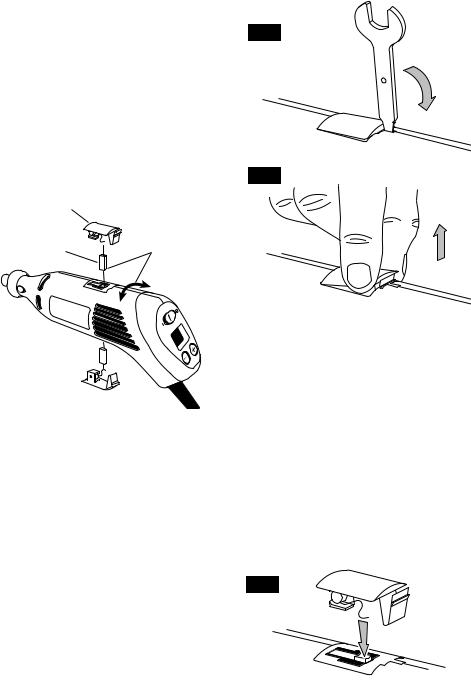
Maintenance
|
Service |
|
|
Preventive maintenance per- |
|
! WARNING |
||
formed by unauthorized person- |
nel may result in misplacing of internal wires and components which could cause serious hazard. We recommend that all tool service be performed by a Dremel Service Facility.
CARBON BRUSHES
The brushes and commutator in your tool have been engineered for many hours of dependable service. To maintain peak efficiency of the motor, we recommend every two to six months the brushes be examined. Only genuine Dremel replacement brushes specially designed for your tool should be used.
BRUSH |
|
|
DOOR |
CURVED END OF |
|
|
||
|
BRUSH MUST |
|
BRUSH |
MATCH CURVATURE |
|
OF HOUSING |
||
|
BRUSH
SPRING 

MAINTENANCE OF REPLACEABLE BRUSHES MODEL 398
The brushes should be inspected frequently when tools are used continuously. If your tool runs sporadically, loses power, makes unusual noises or runs at a reduced speed, check the brushes. To continue using the tool in this condition will permanently damage your tool.
To Remove Brush Door
Disconnect the tool from the power supply. Each brush door is held in place by a snap latch. To disengage latch, place screwdriver end of wrench (included) in slot at rear of door and pry up as shown in Figure 1. With latch disengaged, using a little force, pull up rear of door and lift away brush door and spring assembly from housing, Figure 2.
Check Both Brushes
Turn tool so the brush falls out of holder and check each brush. If the brush is less than 1/8" long and the end surface of the brush that contacts the commutator is rough and/or pitted, they should be replaced. Check
FIG. 1
FIG. 2
both brushes. Usually the brushes will not wear out simultaneously. If one brush is worn out, replace both brushes. Make sure the brushes are installed as illustrated. The curved surface of the brush must match the curvature of the commutator.
To Replace Brush Door
Rest squared underside of brush door on the squared cavity openings. Check to be sure the spring rests on the V groove of the brush, Figure 3. Push front of door down into the slot, Figure 4, then push down and snap the rear latch into it’s slot, Figure 5.
After replacing brushes the tool should be run at noload; place it on a clean surface and run it freely for 5
Any Questions Call
1-800-437-3635 (1-800-4-DREMEL)
FIG. 3
Page 16
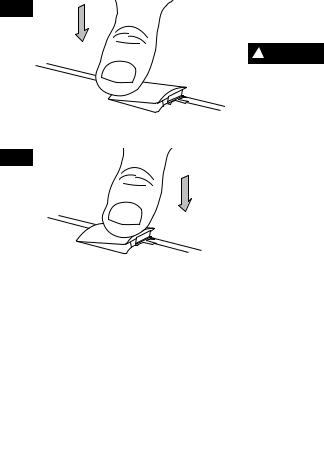
FIG. 4 |
Ventilation openings and switch levers must be kept |
||
|
clean and free of foreign matter. Do not attempt to clean |
||
|
by inserting pointed objects through openings. |
||
|
! |
CAUTION |
Certain cleaning agents and |
|
solvents damage plastic parts. |
||
|
|
|
|
|
Some of these are: gasoline, carbon tetrachloride, chlo- |
||
|
rinated cleaning solvents, ammonia and household |
||
|
detergents that contain ammonia. |
||
FIG. 5
minutes before loading (or using) the tool. This will allow the brushes to “seat” properly and will give you more hours of life from each set of brushes. This will also extend the total life of your tool since the commutator surface will “wear” longer.
BEARINGS
Model 398 has ball bearing construction. Under normal use no additional lubrication is required.
Cleaning
! |
CAUTION |
To avoid accidents always dis- |
|
connect the tool from the power |
|||
|
|
supply before cleaning or performing any maintenance. The tool may be cleaned most effectively with compressed dry air. Always wear safety goggles when cleaning tools with compressed air.
Extension Cords
! WARNING |
If an extension cord is |
|
necessary, a cord with adequate |
||
|
size conductors that is capable of carrying the current necessary for your tool must be used. This will prevent excessive voltage drop, loss of power or overheating. Grounded tools must use 3-wire extension cords that have 3-prong plugs and receptacles.
RECOMMENDED SIZES OF EXTENSION CORDS 120 VOLT ALTERNATING CURRENT TOOLS
Tool’s |
Cord Size in A.W.G. |
Wire Sizes in mm2 |
|||||||
Ampere |
|
|
|
|
|
|
|
|
|
Cord Length in Feet |
Cord Length in Meters |
||||||||
Rating |
|||||||||
|
25 |
50 |
100 |
150 |
15 |
30 |
60 |
120 |
|
3-6 |
|
|
|
|
|
|
|
|
|
18 |
16 |
16 |
14 |
.75 |
.75 |
1.5 |
2.5 |
||
6-8 |
18 |
16 |
14 |
12 |
.75 |
1.0 |
2.5 |
4.0 |
|
8-10 |
18 |
16 |
14 |
12 |
.75 |
1.0 |
2.5 |
4.0 |
|
10-12 |
16 |
16 |
14 |
12 |
1.0 |
2.5 |
4.0 |
— |
|
12-16 |
14 |
12 |
— |
— |
— |
— |
— |
— |
|
|
|
|
|
|
|
|
|
|
|
NOTE: The smaller the gauge number, the heavier the cord.
Page 17

Dremel Accessories
! |
WARNING |
Use only Dremel Tested, High Performance Accessories. Other accessories are not |
|
designed for this tool and may lead to personal injury or property damage. |
|||
|
|
The number and variety of accessories for the Rotary Tool are almost limitless. There is a category suited to almost any job you might have to do — and a variety of sizes and shapes within each category which enables you to get the perfect accessory for every need.
Refer to the DREMEL ACCESSORY ORDER FORM for illustrations of the accessories available. These accessories may be found at your local hardware, hobby or home center dealers.
Collets
If you expect to use a variety of accessories, we recommend that in the beginning you purchase a complete set of four collets. Store these so that you will have the proper size of collet for any accessory or drill bit you want to use. Currently, the 1/8", 3/32",1/32" and 1/16" collets accommodate all of the available Dremel accessories. 1/8" collets are included in most rotary tool kits.
Mandrels
A mandrel is a shank with a threaded or screw head, which are required when you use polishing accessories, cutting wheels, sanding discs, and polishing points. The reason mandrels are used is that sanding discs, cutting wheels and similar accessories must be replaced frequently. The mandrel is a permanent shank, allowing you to replace only the worn head when necessary, thus saving the expense of replacing the shaft each time.
Screw Mandrel No. 401
This is a screw mandrel used with the felt polishing tip and felt polishing wheels. 1/8" shank.
Small Screw Mandrel No. 402
This is a mandrel with a small screw at its tip, and is used with emery and fiberglass cutting wheels, sanding discs and polishing wheels. 1/8" shank.
Threaded Tip Mandrel No. 424
This is a mandrel with a threaded tip which threads into the polishing point accessory No. 427. 1/8" shank.
High Speed Cutters
Available in many shapes, high speed cutters are used in carving, cutting and slotting in wood, plastics and soft metals such as aluminum, copper and brass. These are the accessories to use for freehand routing or carving in wood or plastic, and for precision cutting. Made of high quality steel. 1/8" shank.
Tungsten Carbide Cutters
These are tough, long-lived cutters for use on hardened steel, fired ceramics and other very hard materials. They can be used for engraving on tools and garden equipment. 1/8" shanks.
Engraving Cutters
This group has a wide variety of sizes and shapes, and are made for intricate work on ceramics (greenware), wood carvings, jewelry and scrimshaw. They often are used in making complicated printed circuit boards. They should not be used on steel and other very hard materials but are excellent on wood, plastic and soft metals. 3/32" shank.
Structured Tooth
Tungsten Carbide Cutters
Fast cutting, needle-sharp teeth for greater material removal with minimum loading. Use on fiberglass, wood, plastic, epoxy and rubber. 1/8" and 1/4" shank.
Aluminum Oxide Grinding Stones (red/brown)
Round, pointed, flat — you name the shape and there is one available in this category. These are made of aluminum oxide and cover virtually every possible kind of grinding application. Use them for sharpening lawn mower blades, screwdriver tips, knives, scissors, chisels and other cutting tools. Use to remove flash from metal castings, deburring any metal after cutting, smoothing welded joints, grinding off rivets and removing rust. These grinding stones can be resharped with a dressing stone. In machine shops, high speed drills and cutters normally are ground with aluminum oxide wheels. 1/8" shank. 
Silicon Carbide Grinding Stones (blue/green)
Tougher than aluminum oxide points, these are made especially for use on hard materials such as glass and ceramics. Typical uses might be the removal of stilt marks and excess glaze on ceramics and engraving on glass. 1/8" shank.
Diamond Wheel Points
Excellent for fine detail work on wood, jade, ceramic, glass and other hard material. Bits are covered with diamond particles. 3/32" shanks.
Page 18

Wire Brushes
Three different shapes of wire brushes are available.
Never use wire brushes at speeds greater than 15,000 RPM. Refer to Operating Speeds section for proper tool speed setting. The three shapes come in three different materials: stainless steel, brass and carbon wire. The stainless steel perform well on pewter, aluminum, stainless steel, and other metals, without leaving "after-rust". Brass brushes are non sparking, and softer than steel; making them good for use on soft metal like gold, cooper and brass. The carbon wire brushes are good for general purpose cleaning.
Bristle Brushes
These are excellent cleaning tools on silverware, jewelry and antiques. The three shapes make it possible to get into tight corners and other difficult places. Bristle brushes can be used with polishing compound for faster cleaning or polishing.
Brushing Pressure
1.Remember, the tips of a wire brush do the work. Operate the brush with the lightest pressure so only the tips of the wire come in contact with the work.
2.If heavier pressures are used, the wires will be overstressed, resulting in a wiping action; and if this is continued, the life of the brush will be shortened due to wire fatigue.
3.Apply the brush to the work in such a way that as much of the brush face as possible is in full contact with the work. Applying the side or edge of the brush to the work will result in wire breakage and shortened brush life.
CORRECT:
Wire tips doing the work.
15°
INCORRECT:
Excessive pressure can cause wire breakage.
Polishing Accessories
These include an impregnated polishing point and an impregnated polishing wheel for bringing metal surfaces to smooth finish; a felt polishing tip and felt polishing wheel, and cloth polishing wheel, all used for polishing plastics, metals, jewelry and small parts. Also included in this group is a polishing compound (No. 421) for use with the felt and cloth polishers.
Polishing points make a very smooth surface, but a high luster is obtained using felt or cloth wheels and polishing compound. For best results polishing accessories should be used at speeds not greater than 15,000 RPM. Refer to Operating Speeds section for proper tool speed setting.
No polishing compound is needed when using the 425 Polishing Wheel or 427 Polishing point.
Aluminum Oxide Abrasive Wheels
Use to remove paint, deburr metal, polish stainless steel and other metals. Available in fine and medium grits. 1/8" shank.
Sanding Accessories
Sanding discs in fine, medium and coarse grades are made to fit mandrel No. 402. They can be used for nearly any small sanding job you might have, from model making to fine furniture finishing. In addition, there is the drum sander, a tiny drum which fits into the Rotary Tool and makes it possible to shape wood, smooth fiberglass, sand inside curves and other difficult places, and other sanding jobs. You replace the sanding bands on the drum as they become worn and lose their grit. Bands come in fine and coarse grades. Flapwheels grind and polish flat or contoured surfaces. They are used most effectively as a finishing sander after heavier surface sanding and material removal is completed. Flapwheels come in fine and coarse grades. Buffs are a great finishing accessory for cleaning and light sanding. They work effectively on metal, glass, wood, aluminum and plastics. Coarse and medium buffs are sold together. 1/8" shank.
Grinding Wheel
Use for deburring, removing rust, and general purpose grinding. Use with Mandrel #402.
Page 19

Dremel Accessories - (Cont.)
Cutting Wheels
These thin discs of emery or fiberglass are used for slicing, cutting off and similar operations. Use them for cutting off frozen bolt heads and nuts, or to reslot a screw head which has become so damaged that the screwdriver won’t work in it. Fine for cutting BX cable, small rods, tubing, cable and cutting rectangular holes in sheet metal.
Drywall Cutting Bit
Gives you fast, clean cuts in drywall.
Tile Cutting Bit
Cuts ceramic wall tile, cement board, and plaster.
Spiral Cutting Bit
Cuts through all types of wood and wood composites.
High Speed Router Bits
For routing, inlaying, and mortising in wood and other soft materials. Use only with Dremel No. 330 Router attachment or No. 231 Shaper/Router table.
Mandrel No. 401 is used with the felt polishing tip and wheels. Thread the tip on to the screw carefully. The felt tip must thread down straight on the screw Mandrel, and be turned all the way to the collar.
Mandrel No. 402 has a small screw at its tip, and is used with emery cutting wheels and sanding discs. Higher speeds, usually maximum, are best for most work, including cutting steel. Which is shown here.
Page 20

The machine-screw threading on Mandrel No. 424 threads into polishing point No. 427. This and other threaded mandrels must be screwed firmly down to the collar before being used.
To replace a band on the Drum Sander, loosen the screw without removing it to contract the drum then slide the old band off. Slide the new sanding band on and then expand the drum by tightening the screw once again.
! WARNING |
Before each use, check to make certain that all components are assembled to accessory |
shank and that the drum is sufficiently expanded to secure the band during use. If sanding |
band is loose on the drum during operation it may “fly” off and strike you or bystanders.
Dremel Attachments
565 |
566 |
|
Multipurpose Cutting Kit |
Tile Cutting Kit |
|
• Includes 2 drywall cutting bits (560) and 1 spiral |
• Includes 1 ceramic tile cutting bit (562) |
|
cutting bit (561) |
• Cuts ceramic wall tile to any shape |
|
• Cuts fiberglass, wood & drywall easily |
||
|
Questions or Problems? Call 1-800-437-3635
Page 21
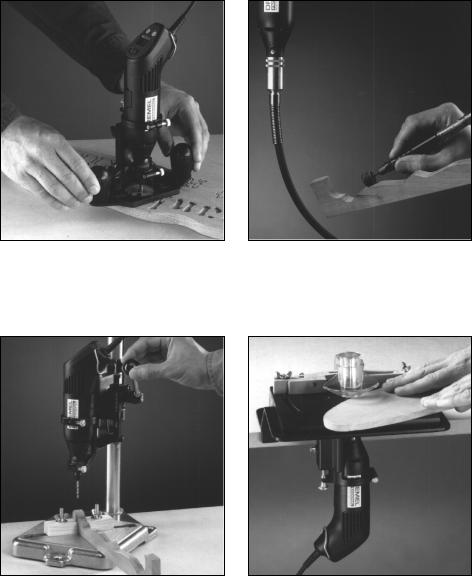
Dremel Attachments
Add these Dremel attachments to your compact workshop and make your Rotary Tool more versatile.
Model 330 Router Attachment
Shapes, edges, chamfers, cuts, rabbets, dadoes, etc. Adjustable edge guide can be easily removed for freehand routing. The Model 330 can be used with Models 270, 275, 280, 285, 380, 395, 398, and 850.
Model 225 Flex-Shaft
Allows finger-tip control for tight corners and hard- to-reach areas. 36" long cable attaches to Models 275, 285, 395, 398, and 850. Pencil-like 1/2" diameter hand piece is cool-running and ideal for light duty wood carving and other uses.
Model 212 Drill Press
For precision drilling, routing, grooving, 6" square work surface, 0" to 3" throat depth. Table slotted for guides, hold downs. Holds Models 275, 285, 395, 398, and 850.
Model 231 Shaper/Router Table
Converts the Rotary Tool into a bench mounted wood shaper. Clamp it to a workbench and perform professional quality slotting, edge trimming, grooving and sanding of irregular shapes accurately and with ease. Large 8" x 6" worktable. Use with Models: 270, 275, 280, 285, 370, 380, 395, 398, and 850.
Page 22

Dremel Limited Warranty
Your Dremel Rotary Tool is warranted against defective material or workmanship for a period of five years from date of purchase. In the event of a failure of a product to conform to this written warranty, please take the following action:
1.DO NOT return your product to the place of purchase.
2.Carefully package the product by itself, with no other items, and return it, freight prepaid, along with:
A.A copy of your dated proof of purchase (please keep a copy for yourself).
B.A written statement about the nature of the problem.
C.Your name, address and phone number to:
UNITED STATES |
|
|
Dremel Service Center |
|
Dremel Service Center |
4915 Twenty-First Street |
OR |
4631 E. Sunny Dunes |
Racine, Wisconsin 53406 |
|
Palm Springs, CA 92264 |
1-800-437-3635 |
|
1-800-275-2052 |
CANADA |
|
OUTSIDE |
Giles Tool Agency |
|
CONTINENTAL UNITED STATES |
6520 Lawrence Av. East |
|
See your local distributor or write |
Scarborough, Ont. |
|
to Dremel, 4915 Twenty-First St. |
Canada M1C 4A7 |
|
Racine, Wisconsin 53406 |
1-888-285-3476 |
|
|
We recommend that the package be insured against loss or in transit damage for which we cannot be responsible.
This warranty applies only to the original registered purchaser. DAMAGE TO THE PRODUCT RESULTING FROM TAMPERING, ACCIDENT, ABUSE, NEGLIGENCE, UNAUTHORIZED REPAIRS OR ALTERATIONS, UNAPPROVED ATTACHMENTS OR OTHER CAUSES UNRELATED TO PROBLEMS WITH MATERIAL OR WORKMANSHIP ARE NOT COVERED BY THIS WARRANTY.
No employee, agent, dealer or other person is authorized to give any warranties on behalf of Dremel. If Dremel inspection shows that the problem was caused by problems with material or workmanship within the limitations of the warranty, Dremel will repair or replace the product free of charge and return product prepaid. Repairs made necessary by normal wear or abuse, or repair for product outside the warranty period, if they can be made, will be charged at regular factory prices.
DREMEL MAKES NO OTHER WARRANTY OF ANY KIND WHATEVER, EXPRESSED OR IMPLIED, AND ALL IMPLIED WARRANTIES OF MERCHANTABILITY AND FITNESS FOR A PARTICULAR PURPOSE WHICH EXCEED THE ABOVE MENTIONED OBLIGATION ARE HEREBY DISCLAIMED BY DREMEL AND EXCLUDED FROM THIS LIMITED WARRANTY.
This warranty gives you specific legal rights and you may also have other rights which vary from state to state. The obligation of the warrantor is solely to repair or replace the product. The warrantor is not liable for any incidental or consequential damages due to any such alleged defect. Some states do not allow the exclusion or limitation of incidental or consequential damages, so the above limitations or exclusion may not apply to you.
For prices and warranty fulfillment in the continental United States, contact your local Dremel distributor.
Exportado por: Robert Bosch Tool Corporation Mt. Prospect, IL 60056 -2230, E.U.A.
Importado en México por: Robert Bosch, S.A. de C.V., Calle Robert Bosch No. 405, Zona Industrial, Toluca, Edo. de México, C.P. 50070, Tel. (722) 2792300
Page 23
